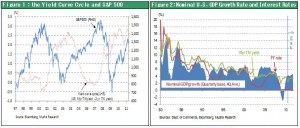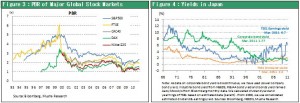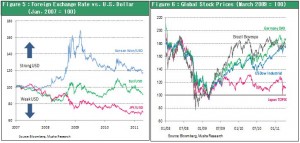The brief respite in risk-on sentiment
The global stock market rally is currently taking a break. We are seeing a pause in investors’ appetite for risk in the wake of the market recovery that followed the sharp drop triggered by the March 11 earthquake in Japan. But rising stock prices in emerging countries demonstrate that investors have not become completely averse to risk. There are a number of concerns about the outlook: (1) fiscal deficits, (2) increasing inflation driven by the high price of crude oil and other sources, (3) geopolitical instability in the Middle East and other regions, and (4) uncertainty about the damaged nuclear power plants in Japan. However, none of these concerns are new, so they are not causing worries among investors to grow.
Risk-on trading will continue as investors still have difficulty finding attractive investments
Only one major source of concern exists: the impact of the upcoming shift in U.S. monetary easing (the exit from QE2). Bill Gross of PIMCO is on the far right wing of alarmists. He believes that the end of QE2 will lead to sales of U.S. Treasuries. According to The Financial Times, he is reducing his weighting of Treasury securities and increasing cash (short-term government bonds). That means Mr. Gross expects the yield curve to steepen. However, a steeper yield curve is not a negative for risk-taking. This is because, based on the scenario that Mr. Gross foresees, a tight-money policy will be enacted only at a moderate pace and the margins at financial institutions become even larger. Even the leader of the alarmists has not adopted a risk aversion (risk-off) stance. This is a sign that financial markets are about to enter a phase that further increases the appetite of investors for risk. Tight-money policies produced a sharp increase in interest rates and instability in financial markets in 1994 during the Mexican currency crisis. But monetary tightening is unlikely to create these same problems this time. We are very likely to see an exit from monetary easing that is prudent and slow. As a result, it is difficult to imagine this policy shift having a significant impact on risk-taking sentiment among investors. (See Bulletin No. 40)

The Greenspan conundrum ? High probability that the Goldilocks scenario will reappear
The downturn in U.S. housing prices will begin to end as the sustainability of the U.S. economic recovery becomes increasingly apparent. U.S. credit creation has started to produce growth in business loans. Although we may see the first interest rate hike in the second half of 2011, a series of rate hikes is unlikely because the risk of inflation is under control. Consequently, the upturn in long-term interest rates will probably be limited. I have just described the reappearance of the Greenspan conundrum (Goldilocks scenario): a favorable environment in which companies report higher earnings due to a strong economy but market interest rates do not climb. Since early in 2010, U.S. nominal economic growth has consistently exceeded long-term interest rates, which have remained at the 3% level. The Greenspan conundrum, which was temporally interrupted by the Lehman shock, is becoming established once again. (See Key Strategy Issues Vol. 290 “The QE2 Shock: A New Age of Financial Monetary Policies That Target Asset Prices” for a discussion of why this conundrum is reappearing and what is the ramifications of this reappearance.) We believe this economic climate is very likely to continue for some time. That means investors will continue to see a favorable environment for risk-taking on a global scale.
Japanese stocks are virgin territory for global investors
Investors have ample funds and an upturn in their appetite for risk is anticipated. On the other hand, the number of attractive investments is extremely limited. U.S. stocks are no longer as undervalued as before. As a result, the spotlight is about to shift to Japanese stocks, which are virgin territory in the realm of global risk assets. First, Japanese stocks are lagging far behind the global stock market recovery that followed the Lehman shock (because of the yen’s extreme strength and reemergence of deflation). Second, Japanese stocks are remarkably undervalued in terms of their valuations (I will not present details here, but Japanese stocks have the world’s lowest PBR and highest risk premium*). Therefore, once investors are no longer worried about problems created by the recent earthquake, Japanese stocks will probably become a perfect target for global investors who are now starving for attractive opportunities. After the current waiting period for full-scale recovery and reconstruction initiatives ends in a few months, the Japanese economy is likely to begin posting strong growth in the second half of 2011. If this happens, deflation will probably end and investors will start buying Japanese stocks.
*Stock yield (Earnings per share/Stock price) ? Real long-term interest rate
The earthquake will be the start of Japan’s revitalization
The March 11 earthquake is very likely to bring about the end of deflation that has plagued Japan for two decades. The first reason is that the disaster will narrow the gap between supply and demand while prompting the government to enact reflationary policies. Massive public-sector expenditures will be vital to dealing with damage that totals anywhere from \16 trillion to \25 trillion. Furthermore, the government must immediately use emergency measures to supply liquidity. That means we are about to see the government begin full-scale reflationary initiatives compared with the small-scale actions prior to this disaster. The second reason involves the unexpected joint foreign exchange market intervention by the G7 in response to the earthquake. Taking this step will probably bring an end to the prolonged upturn in the yen’s value. G7 interventions have taken place five times in the past. Every one signaled the end of a long-term foreign exchange trend. This time as well, the intervention will probably be successful because it is in step with fundamentals. Japan will be forced by the earthquake to further ease its monetary policies. At the same time, the United States and Europe are starting to look for ways to end their easy-money policies. The gap between interest rates in Japan and other countries will probably widen as a result. If the yen weakens, wages in Japan will become cheaper compared with other countries. This would give Japan the opportunity to raise wages. Higher wages may also be the event that ends asset deflation in Japan.
A strong sentiment has emerged among the Japanese public to abandon worries and pessimism and instead focus on moving forward. The earthquake was a devastating blow. Nevertheless, some years from now we may very well look back on March 11 as a day that gave Japan the opportunity to embark on its revitalization.






